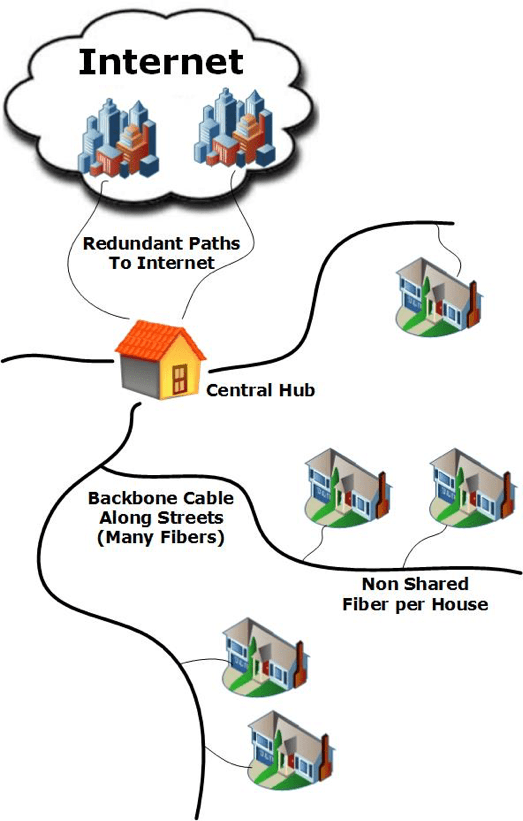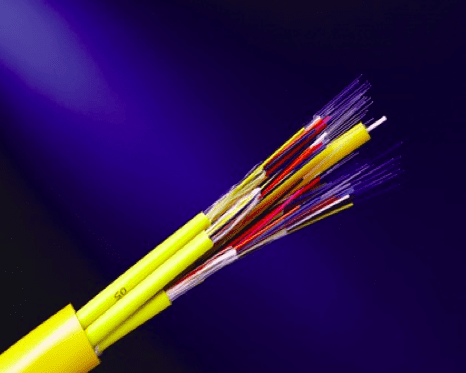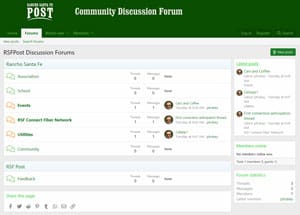From the MyRSF.net archives of the RSF Post
Last Piece of the Puzzle
Author: Phil Trubey
Date: September 12, 2017
This is it! We are finally ready to start building our 1 Gbps fiber optic network! The last six months have been busy with finalizing construction plans, negotiating with the County of San Diego to bury the fiber network in its roads, lining up third-party service providers, and performing financial analysis and projections.
The last piece of the puzzle is YOU! Specifically, this week you will receive a voter information packet in the mail asking you to vote FOR building the fiber optic network. Assuming we get a positive result by early October, the RSFA will immediately submit construction plans to the County. Once the permit is issued, we start building. It is as simple as that.
 In this article, I'd like to describe the technology choices we've made in designing this network. I'll explain the basics of fiber networks, our backbone architecture, shared versus dedicated bandwidth, 1 Gbps versus 10 Gbps, and network reliability.
In this article, I'd like to describe the technology choices we've made in designing this network. I'll explain the basics of fiber networks, our backbone architecture, shared versus dedicated bandwidth, 1 Gbps versus 10 Gbps, and network reliability.
Our network is an all-fiber network extending from the nearby major Internet connection points in Los Angeles down to our central hub here in Rancho Santa Fe, and then onto the backbone fibers under our streets to your house, and then all the way into your house where it finally terminates at an Optical Network Terminal (ONT). At that point, the Internet data would typically be distributed in your house over gigabit copper Ethernet or WiFi (or both).
The Internet data is being carried by very fast pulses of laser light over very thin strands of glass that look like this:
 This is a backbone cable that contains 72 individual strands of fiber optic glass. In our design, each house will have one dedicated fiber strand from the central hub.
This is a backbone cable that contains 72 individual strands of fiber optic glass. In our design, each house will have one dedicated fiber strand from the central hub.
Most existing and new neighborhood fiber networks economize by sharing one fiber from the central hub among 32 houses. These 32 houses then share 2.5 Gbps of bandwidth back to the central office. If you've heard of Google's metropolitan fiber networks, this is the approach they took.
We have opted to do something a bit different. Our network dedicates a single optical fiber to each house from the central hub building. We realized that most of the cost of building the network was in trenching roads, and the actual cost of the optical fiber cable itself is relatively small. So we opted to spend a little bit more (around 10%) for dedicated fiber to each house. This provides a more future-proof network than what a telephone or cable company would typically build. This is one reason why we can say that this network will have sufficient bandwidth and not need replacing for 50+ years.
One question that some technology savvy people ask is, why stop at 1 Gbps? Why can't I have 10 Gbps? Actually, our fiber and the network design could allow 10 Gbps speeds from day one. But there are several reasons why we won't offer that speed initially. Home networks cannot use more than 1 Gbps since the fastest network that people have in their homes only runs at 1 Gbps. To have a 10 Gbps home network, you would have to rewire your house with either very expensive, special-purpose copper wires, or fiber optics instead of the usual Cat 5e Ethernet cables. And then only PCs (with special 10 Gbps network cards) would be able to run at that speed. Wireless isn't an option. Wifi cannot even match 1 Gbps speeds, let alone 10 Gbps.
The fiber optic backbone is structured such that when people are ready for and want more than 1 Gbps, the network will be able to provide it. In the near future, a 10 Gbps home network may be more practical.
One of the key things we wanted to design into our network was utmost reliability. No service outages! Of course it is impossible to have 100% uptime forever, but you can design to minimize outages. Our network reliability starts with the fact that we are using fiber optics, which is immune to electrical "noise" that plague all other forms of copper wiring such as telephone or cable TV.
We also decided early on that this was going to be an all underground network, meaning no use of utility poles. As you know, Rancho Santa Fe has all-too-frequent car crashes into utility poles. By burying our network several feet underground, we eliminate one source of downtime. In a similar vein, we opted to design a network that has no above-ground utility boxes at the side of the road. All connection points will be buried (while still accessible via locked vault tops for maintenance).
Equipment power supplies don't last forever, and the more pieces of equipment that require power, the more outages you are going to have. The only equipment that needs power in our network is the optical switch in the central hub and the ONT in your house. The central optical switch will have redundant power supplies, a battery backup, and a generator in case of power failure. The central hub building will also have redundant cooling.
We will also have redundant backbone uplink paths to the Internet so if one link becomes damaged, we will still have access to the Internet. And, of course, all pieces of our network will be continually monitored.
Finally, even if all equipment and backbones are operating, there might be something wrong with your particular network. We will be choosing a service provider that has 24/7 customer support with actual technicians on the phone to take your calls.
In summary, this is truly a world class network. We were blessed with world class technical experts on the RSFA Technology Committee during the design, world class financial experts on the Finance Committee to determine how to pay for it, and world class leadership on the Board and in the Association staff to manage its execution. Rancho Santa Fe, as befitting its status as a world class community, deserves no less. This fiber optic network will ensure that Rancho Santa Fe continues to be one of the most desirable places to live in the world.
 Discuss this article in the RSF Connect Fiber Network forum.
Discuss this article in the RSF Connect Fiber Network forum.

 Chronicles
Chronicles